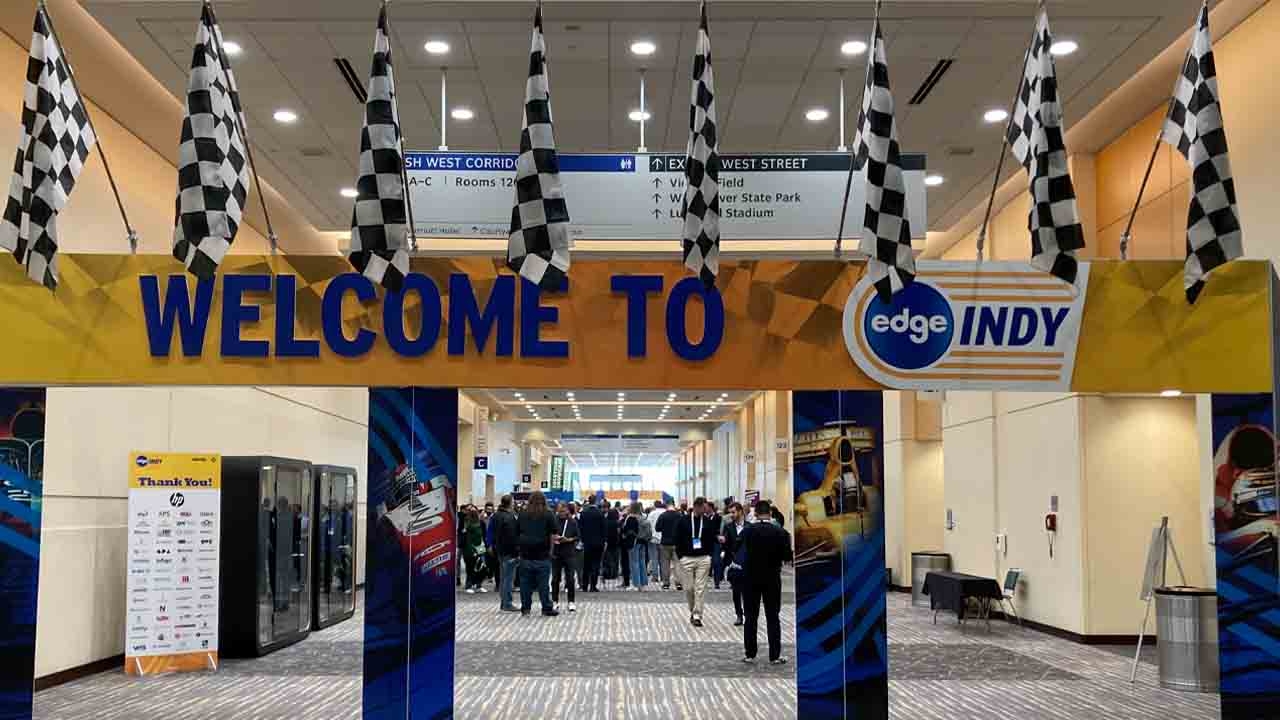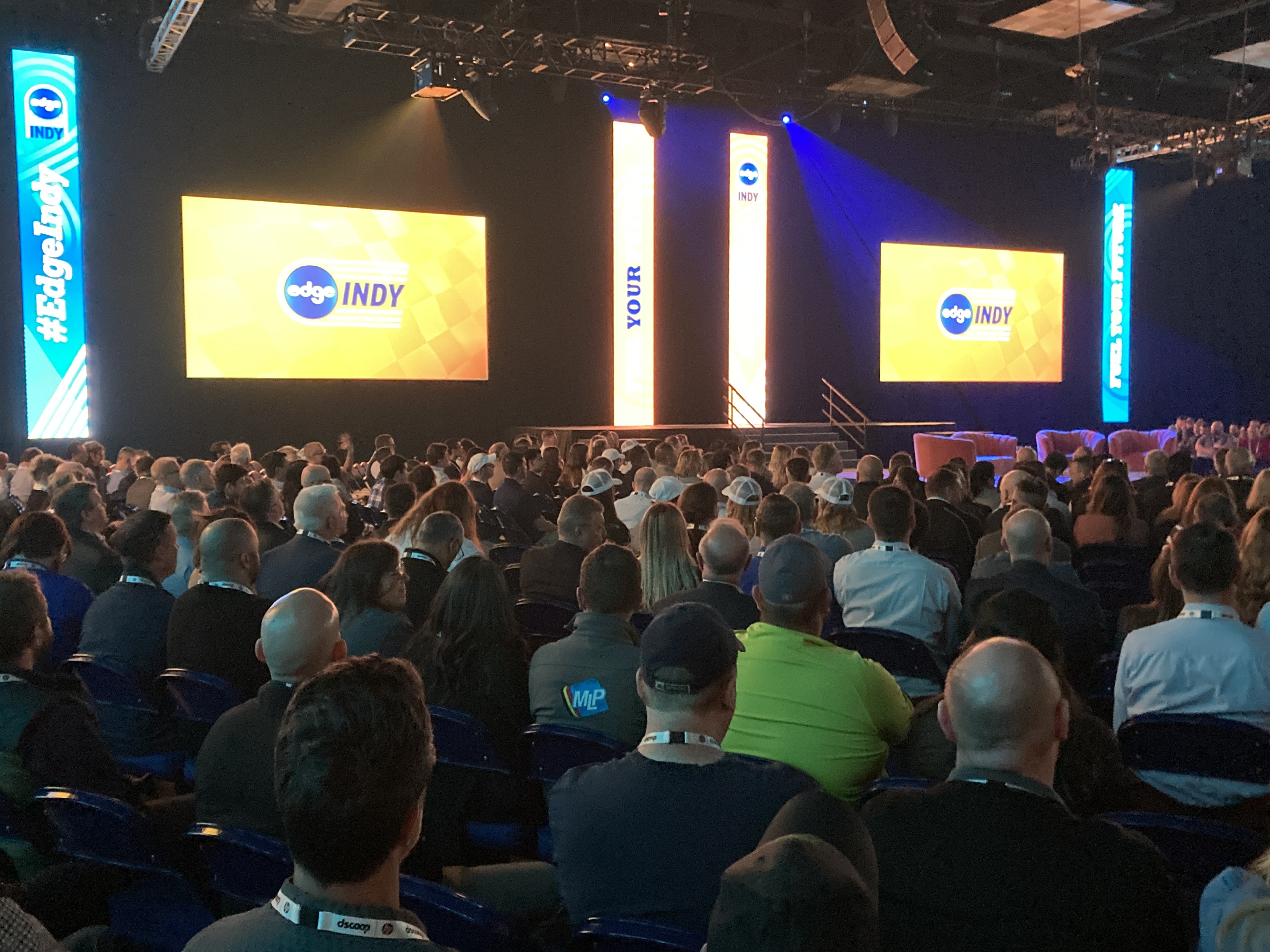A digital revolution: Dscoop empowers print industry
Dscoop Edge Indy arrives in Indianapolis and brings 1,200 attendees from 37 countries.

Robots don’t get sick; they don’t take days off; and the only breaks they need are to charge their batteries, or for maintenance and repair.
Automation and artificial intelligence (AI) took center stage at this year’s Dscoop Edge Indy, in Indianapolis, Indiana on March 24–27. One highlight was an autonomous mobile robot (AMR) designed for the printing industry from MoviĜo Robotics.
Named after sharks that must keep moving to breathe, the Ŝharko5 debuted on the Solutions Showcase showfloor at Dscoop Edge Indy. That robot on display was purchased by Cober Solutions, a commercial printer in Kitchener, Ontario, which plans to use it to move materials around the warehouse and eventually to the press.
‘Robots can still run around after the shop’s closed,’ says Erwin Driever, VP of technology at Cober and a panelist on ‘Adopting a Digital Automation Mindset for Transformative Growth.’
From commercial printers to label converters, interest in automation has risen to new heights.
‘Automation is key,’ several speakers said at one time or another during the two-and-a-half-day event.
With over 45 education sessions focused on industry trends and three celebrity keynotes, Dscoop 2024 drew 1,200 attendees from 37 countries with 70 partners exhibiting, offering insight into how the digital print community is pivoting to stay relevant in the increasingly competitive space.
At its annual flagship event hailed as the biggest digital print community, HP announced three new digital presses for the commercial print space. Meanwhile, the HP Indigo V12 digital press, first showcased at Labelexpo Americas 2022 and Labelexpo Europe 2023, was also on the Indianapolis show floor. HP announced that the V12 will now be commercially available after successful beta-site installations at, among others, a Brook + Whittle facility in Hamilton, Ohio.
The evolution of automation
‘The Morning Show: Automation in Print’ featured commercial printers who shared various ways automation is changing the workflow at their respective companies, with lessons for the label industry.
‘We have a robot,’ says Christopher Burnley of Corefact in San Leandro, California. The company has a USD 15,000 bot from MūL Technologies that he estimates eliminates 66 trips per day just moving jobs.
The leaders hail from different backgrounds and markets but they all agree the key is to use automation to eliminate non-value adding activities — like walking over jobs — to free up skilled labor for those value-adding jobs.
‘Automation helps take time out in-between,’ Beck says. ‘If I can have a robot move jobs and employees process more jobs, it’s a win-win.’
‘Automation is not about replacing employees but “repurposing” their time spent on menial jobs for “higher-level” tasks,’ Gavin Rittmeyer, vice president, sales and marketing at Martin Automatic, says from the exhibit floor.
Still, for those still unsure about how to begin automating their business, the panelists advise starting small, perhaps focusing on one aspect like sales or marketing.
Automation helps take time out in-between. If I can have a robot move jobs and employees process more jobs, it’s a win-win
Another piece of advice they offered was to involve employees in the automating process because they know where the redundancies are and where inefficiencies can be eliminated.
‘Automation is an evolution,’ Burnley says, adding the ‘ultimate Holy Grail’ would be to automate the entire process from beginning to end — customer acquisition to finishing, and possibly even shipping and returns.
Plus, ‘the great thing about a robot is it shows up to work every day,’ Burnley adds, a sentiment the other panelists vehemently emphasized.
Former professional baseball shortstop and businessman Alex Rodriguez also weighed in on AI during his keynote.
He didn’t graduate from college, but he’s now teaching a class on strategic pivoting at Stanford University, and he tells the Dscoop audience: ‘AI is coming for all of us.’ Rodriguez further challenged the audience: ‘What are you doing as a business to position yourself, so it enhances your company, not destroys it?’
‘A blue ocean’ of opportunity
Another way some companies are staying relevant is by diversifying with flexible packaging, a natural segue for label converters.
During a packed session on ‘Double-Digit Growth: New Opportunities in Flexible Packaging,’ those eyeing flexible packaging heard from digital disruptors like Charles Christopher of All State Printing, Felipe Toledo of Camargo Embalagens and Gary Whitehead of Traco Packaging.
‘HP Indigo flexible packaging customers are seeing 135 percent year-over-growth since 2019, generating over USD 1 billion in sales revenue,’ panel moderator Alon Schnitzer of HP says. ‘It’s like a blue ocean. There’s plenty of opportunities and a lot of places to grow in the flexible packaging arena.’

All State Printing has seen growth double every year since its founding in 2019, having found its niche in the cannabis and pet foods sectors. ‘It’s an emerging market that has helped us grow significantly,’ Christopher says, and the flexible packaging converter is now looking to add a third press.
However, pivoting into flexible packaging comes with its own set of regulations, and ‘Regulatory Considerations When Moving from Labels to Flexible Packaging in Digital Printing’ by Molly Hladik of Michelman addressed the many layers involved.
The global market for flexible packaging, estimated at 208.7 billion USD in 2023, is projected to reach 360.2 billion USD by 2030, growing at a CAGR of 7.1 percent during the period, according to the ‘Flexible Packaging - Global Strategic Business Report’ from ResearchAndMarkets.com.
Flexible packaging is made up of about 90 percent substrates and laminates, and 10 percent adhesives, with various layers like a durable film so it can be printed, a structural layer so the bag or pouch won’t be punctured, as well as a barrier so the materials do not migrate.
There’s plenty of opportunities and a lot of places to grow in the flexible packaging arena
Compounding that further, Hladik says, there are currently no set regulations in the US or the EU that offer clear guidance on specific ink formulations for food packaging. There are diverse and varying regulations, so there are always conditions and ‘there is always a “but.”’
Hladik says that complex multilayer is what makes it so hard to recycle to add to the challenge of sustainability. But as this growing global mentality of reduce, reuse and recycle continue to shape the future, the industry must continue to innovate new packaging designs to meet their needs.
Partnerships announced
At Dscoop 2024, HP and Esko also announced a partnership to deliver an integrated system for producing digitally printed packaging.
This partnership aims to help packaging converters streamline and automate the packaging value chain. An integrated web portal will enable brand owners to order their packages from converters on-demand, reducing order delivery times from weeks to days, decrease stocks and reduce overall cost.
Whether automation, AI or flexible packaging, it came down to staying relevant.
Todd Cober of Cober Solutions, a panelist during ‘The Morning Show: Digital Transformation – State of the Industry,’ talks about how important that flexibility will be going forward. ‘I’m not going to predict the future; I’m going to prepare for it.’
Cober Solutions is now working with HP to install machine learning on all its equipment. ‘It’s not about whether print will still be relevant in 20 years,’ he says. ‘It’s about providing whatever the consumers still want.’
Jon Bailey, CEO of Precision Proco in the UK and outgoing chair of the Dscoop global board, offers his parting words of wisdom: ‘We must continue to evolve to stay relevant.’ _____________________________________________________________
Sustainablity: The ‘new normal’ for a successful converter
If automation is the next frontier, sustainability seems to be the new normal.
Sessions on sustainability at Dscoop Edge Indy were well-attended and full of practical tips for small businesses that may not know where to start.
‘Initiating Sustainable Print Practices,’ moderated by Rick Bellamy of Infl ection, featured: Brian Scott of Blooming Color, Carlos Lahoz of HP, Jordan Darragh of PrintReleaf, Katy Hart of The BoxMaker and Lori Gobris of Michelman.
‘It’s a journey and you have to start with one step,’ Bellamy says, noting major climate bills in California that took effect at the start of the year.
In October, California Governor Gavin Newsom signed into law the Climate Corporate Data Accountability Act (Senate Bill 253), mandating large companies doing business in the state to report its greenhouse gas emissions (GEG) by 2026 and indirect GEG across its supply chain by 2027.
Earlier this year, a lawsuit was fi led challenging SB 253 and another – Climate-Related Financial Risk Act (SB 261) requiring financial risk disclosures.
Regardless the outcome, if the saying, ‘As California Goes, so goes the nation,’ follows, such a future of similar laws and suits may become the reality across the US, impacting converters and suppliers alike.
The panelists shared how they began their sustainability journey. For The BoxMaker, it started at Dscoop 2023. ‘We want to be prepared for the future; the legislation is coming,’ Hart says.
Companies can start small by controlling and reducing their energy usage and waste production, perhaps calculating the carbon footprint of one print job to start.
Michelman’s Gobris also shared some statistics from the Flexible Packaging Association 2024 Annual Meeting: The US lagged behind other countries in terms of the importance of sustainability: 66 percent of Americans believe in climate change and that humans are the cause. Additionally, 66 percent believe companies – above state and federal governments and individuals – have the responsibility to help correct the issues. Going a step further, 59 percent of Americans believe these companies are responsible for taking care of the full end-of-life of the materials and products they produce.
‘It’s only going to keep increasing in terms of consumer sentiment,’ Gobris adds.
For HP, Lahoz says the focus on sustainability goes back to the foundation of the company, and more than 60 percent of sales now involve conversations about sustainability.
‘We want to be a future-ready company and sustainability is a must,’ he says. ‘The future company will either be sustainable or it will not exist.
_____________________________________________________________
Stay up to date
Subscribe to the free Label News newsletter and receive the latest content every week. We'll never share your email address.

